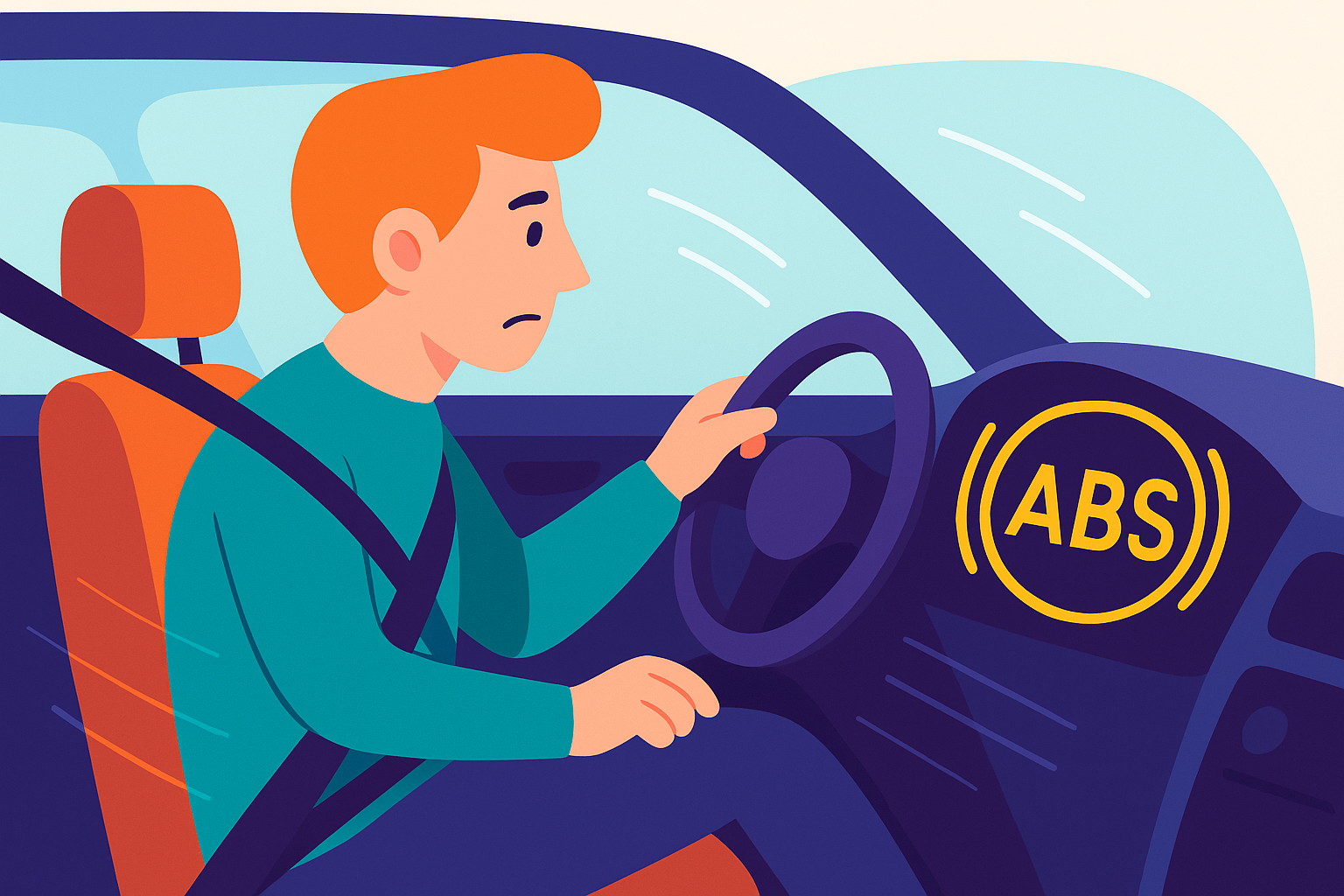Signs of a Bad ABS Module
Last updated:


Introduction
Braking feels simple—press the pedal, slow down—but modern braking is a small miracle of electronics and hydraulics working together. At the heart of that miracle is your ABS (Anti-lock Braking System) module, the electronic “brain” that monitors wheel speed and modulates brake pressure to prevent wheel lock-up. When it’s healthy, you stop in a straight line, maintain steering control on slick roads, and avoid skids. When it’s not… well, your vehicle can still stop, but it gets riskier, noisier, less predictable, and more expensive if you ignore the warning signs.
Here’s the tricky part: ABS problems often masquerade as “normal wear” or get dismissed because the car still stops—until the day you need full braking performance and stability. A failing ABS module can trigger warning lights, lengthen stopping distances, cause random brake lock-ups, or disable traction and stability aids that keep you out of trouble. Catching these symptoms early doesn’t just protect your car; it protects you and everyone riding with you.
Ready to get help now? Start your ABS module repair with UpFix today
The Signs: How to Tell If Your ABS Module Is Going Bad
1) ABS Warning Light That Stays On (or Intermittently Flickers)
If your ABS light illuminates and won’t go out—or cycles on during drives—it’s the system telling you something’s wrong. Intermittent lights can indicate failing internal circuitry, temperature-sensitive solder joints, or moisture intrusion inside the module.
2) Longer Stopping Distances, Especially on Wet or Loose Surfaces
ABS is designed to maintain traction and control. If you notice the car takes longer to stop in the rain or gravel, or you feel reduced pedal feedback under hard braking, the module may not be commanding the pump and valves properly.
3) Wheel Lock-Up in Normal Braking
ABS is meant to prevent lock-up. If one or more wheels lock during moderate stops, the module may be failing to interpret wheel-speed data or actuate valves correctly—often a control-board fault, not just sensors.
4) ABS Pump Running Constantly (Humming/Buzzing)
A continuously running pump is a classic symptom. It can drain the battery, overheat the pump motor, and points to a control fault in the module’s power drivers or relays.
5) “Christmas Tree” Dash: Traction/ESP/Brake Lights Together
Your ABS module communicates with traction control, stability control (ESP/ESC), and sometimes even the speedometer. If multiple lights pop up together, think networked system fault—frequently traced back to the ABS module.
6) Pedal Feels Different: Too Hard, Too Soft, or Pulses at Odd Times
Random pulsation at low speeds, unusually firm pedal feel, or inconsistent braking response can reflect incorrect valve modulation commands inside the module.
7) Scan Tool Codes That Keep Returning
If your tech clears the codes but they return quickly—especially control-module internal faults (like Cxxxx series or “control unit internal failure”)—the issue is likely on the module PCB, not in the wheel sensors or tone rings.
Why Symptoms Get Misdiagnosed (and How to Avoid Paying Twice)
-
Sensor vs. Module: Bad wheel-speed sensors can trigger similar lights, but if multiple sensor codes rotate or the code points to “internal control module,” suspect the module.
-
Wiring/Connector Corrosion: Always worth checking, but repeated return of the same internal-control errors usually means the board itself needs rebuild.
-
Pump/Valve Assemblies: Mechanics sometimes recommend replacing the entire hydraulic unit; often, the electronic module repair alone resolves the issue at a far lower cost.
Pro tip: If codes mention “control module internal,” “pump motor circuit,” or “valve driver” faults—and you’ve ruled out obvious wiring/sensor issues—repairing the module is the smart next step.
The Intermittent Light That Became an Expensive Habit
Vehicle: 2014 Ford F-150
Symptoms: ABS light intermittently on, longer wet-road stops, pump humming after shutdown.
Initial Advice: Dealership quoted full module/hydraulic replacement north of $1,200.
Outcome with UpFix: Customer mailed just the electronic ABS module. Our technicians repaired failed power drivers and reflowed cracked solder joints, then bench-tested across temperature ranges. Total cost was a fraction of replacement, and the pump no longer ran post-ignition. Light stayed off, braking normalized
The Real Risks of Driving With a Failing ABS Module
-
Compromised Stability: Higher likelihood of skids during panic braking.
-
Battery/Pump Damage: Constant pump operation can kill the battery or burn out the motor.
-
Brake Bias Issues: Uneven modulation can prematurely wear pads/rotors and stress the hydraulic system.
-
Insurance & Liability: Post-incident inspections sometimes note stored ABS faults—fixing early is safer and smarter.
What It Usually Isn’t (Common Myths)
-
“If the car stops, the ABS is fine.” Not necessarily—your base brakes can still work while ABS and stability aids are offline.
-
“The fix requires a brand-new unit.” Dealers often replace; we repair the module’s electronics reliably and warrant our work.
-
“Any shop can fix the board.” ABS modules require specialized fixtures, micro-soldering, and automotive-grade testing—this is our lane.
Why UpFix
UpFix is built around one promise: repair quality that rivals replacement at a fraction of the cost.
-
Specialized ABS Expertise: We focus on electronic control boards—pump motor circuits, valve drivers, processor solder joints, and moisture-related corrosion pathways.
-
Advanced Diagnostics: We load-test, thermal-cycle, and simulate wheel-speed/vehicle inputs so the module doesn’t just “work on the bench”—it works in real life.
-
Sustainable & Cost-Effective: Repairing your original module preserves OE fitment, avoids coding headaches, and prevents e-waste.
-
Transparent Turnaround: Clear instructions, status updates, and rapid shipping back to you
How the UpFix Process Works (Mail-In, No Guesswork)
-
Identify Your Module
Locate the ABS/ESP module part number (or tell us your year/make/model and trim). -
Create Your Order
Place a repair order on our site and print your packing slip. -
Pack & Ship
Remove the electronic module from the hydraulic block when possible (we provide guidance). Package securely and ship to UpFix. -
Expert Repair & Testing
We diagnose under magnification, repair the fault (components, traces, reflows), and run full electrical and functional tests—plus thermal cycling. -
Return & Reinstall
Reinstall the module, clear codes, and perform a short road test. Most vehicles need no additional coding when the original module is repaired.
False Sensor Codes That Wouldn’t Quit
Vehicle: 2012 BMW 328i
Symptoms: ABS and traction lights, rotating wheel-speed sensor codes, occasional speedometer dropouts.
Initial Attempts: Owner replaced two sensors and a hub—codes returned within days.
Outcome with UpFix: Our inspection found micro-cracks on the module’s processor-side joints causing intermittent signal interpretation. Precision rework restored proper readings; no more false sensor codes, speedometer stabilized, and stability control re-enabled—without more parts chasing.

FAQs
Q: Can I drive with the ABS light on?
A: Your basic brakes will likely still function, but ABS and stability aids may be compromised. It’s safer to address it quickly, especially before wet or winter conditions.
Q: How do I know it’s the module and not a sensor?
A: If multiple sensor codes rotate, the pump runs constantly, or you see “control module internal” codes that return after clears, the module is a prime suspect.
Q: Do you need my entire hydraulic unit?
A: Usually no. Sending just the electronic module speeds turnaround and avoids brake bleeding. We’ll tell you if a full unit is necessary for your vehicle.
Q: Will I need coding after repair?
A: In most cases, no—because we repair your original module. After installation, clear codes and road test.
Q: How long does repair take once you receive it?
A: Turnaround is typically fast. Exact timing depends on volume and specific faults, but our team moves quickly without compromising quality.
Q: What if the lights come back after reinstall?
A: Start with code clearing and a short drive cycle. If anything persists, contact us—we’ll help troubleshoot and support you.
The Long Conclusion: Drive With Confidence, Not Guesswork
Braking confidence is non-negotiable. An ABS module on the edge won’t always announce itself with dramatic failures; it shows up as longer stops in the rain, a pump that hums after you park, a dash full of warnings, or a speedo that occasionally dips—and then, one day, you really need full control and don’t have it. The good news is that this isn’t a mystery or a money pit. With UpFix, you keep your original equipment, avoid the cost and complexity of a complete replacement, and restore your braking safety with tested, technician-grade repair.
We’ve seen thousands of “unsolvable” ABS problems come down to precise electronic faults: failing drivers, cracked solder joints, and moisture-compromised traces. Repairing the module correctly fixes the root cause, not just the symptom, and keeps your vehicle’s safety systems online when they matter most. You’ll save money, reduce waste, and get back the confident braking feel you expect—without the dealership price tag.
If you’re seeing the signs, take action now—start your ABS module repair with UpFix and get your stopping power (and peace of mind) back today.

 upfix.com
upfix.com 888-979-9343
888-979-9343

